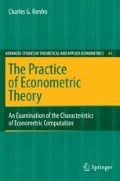Abstract
The present survey has already been criticized, before its completion, as over-narrowly focused, even within its own terms. The argument is that the common use of econometric programming languages during the past approximately 20 years, such as Gauss and Ox (Hill, 1989; Knusel, 1995; Renfro, 2004b, c), among others, has allowed economists to implement diagnostic tests in their day-to-day work, lessening their dependence on packages such as those surveyed here. Consequently, since the sample fails to properly address this possibility, the results are biased. In response to the narrow focus aspect of this indictment, the only defensible answer is “guilty as charged,” if only in a limited sense. Clearly there is considerable scope, excluding the surveyed packages, for econometricians and applied economists to implement a wide range of tests, both now and in the past. Without any doubt, tests have often been implemented that are not described here, but would be relevant to the subject of this survey. If it were also the long-standing disciplinary convention, strong and invariably-honored, for each economist to publish his or her empirical results fully and carefully – or alternatively make them available on a web page or in some other public context in such a way that an interested later investigator could easily by replication determine exactly how to evaluate the computational process involved, then this guilty plea might be cause for chagrin and embarrassment. However, the unscientific nature of the way in which empirical results are much too commonly presented in the economics literature, with the calculations hidden, the particular observational values unidentified – and possibly unavailable publicly – among other problems, leading to well-known replication difficulties (Anderson, Greene, McCullough, & Vinod, 2007; Dewald, Thursby, & Anderson, 1986; McCullough & Vinod, 2003), makes it impossible to give immediate credence to the large majority of the implemented diagnostic tests that are not considered in the present study, which is a reason they have been ignored. This is not a justification per se, but only an explanation.
Access this chapter
Tax calculation will be finalised at checkout
Purchases are for personal use only
References
Dewald, W. G., Thursby,J. G., & Anderson,R. G. (1986). Replication in empirical economics: The Journal of Money, Credit and Banking Project. American Economic Review, 76(4), 587–603
Hill, R. C. (1989). Learning econometrics using Gauss. New York: Wiley
Knusel, L. (1995). On the accuracy of statistical distributions in GAUSS. Computational Statistics and Data Analysis, 20, 699–702
Marshall, A. (1920). Principles of economics (8th ed.). London: Macmillan
McCullough, B. D., & Vinod, H. D. (2003). Verifying the solution from a nonlinear solver: a case study. American Economic Review, 93(3), 873–892
Renfro, C. G. (2004b). Econometric software: The first fifty years in perspective. Journal of Economic and Social Measurement, 29(1–3), 9–108[AU25]
Samuelson, P. A. (1984). Second thoughts on analytical income comparisons. Economic Journal, 94, 267–278
Spiegel, U. (1994). The case of a “Giffin Good”. Journal of Economic Education, 25(2), 137–147
Author information
Authors and Affiliations
Corresponding author
Rights and permissions
Copyright information
© 2009 Springer-Verlag Berlin Heidelberg
About this chapter
Cite this chapter
Renfro, C. (2009). The Implications of the Findings. In: The Practice of Econometric Theory. Advanced Studies in Theoretical and Applied Econometrics, vol 44. Springer, Berlin, Heidelberg. https://doi.org/10.1007/978-3-540-75571-5_9
Download citation
DOI: https://doi.org/10.1007/978-3-540-75571-5_9
Published:
Publisher Name: Springer, Berlin, Heidelberg
Print ISBN: 978-3-540-75570-8
Online ISBN: 978-3-540-75571-5
eBook Packages: Business and EconomicsEconomics and Finance (R0)

